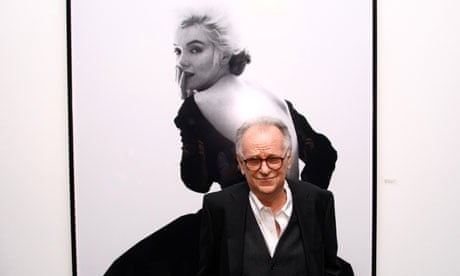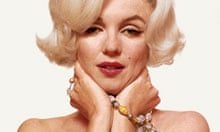In the summer of 1962 Bert Stern, who has died aged 83, took more than 2,500 photographs of Marilyn Monroe over three sessions held in a Los Angeles hotel. The images captured Monroe in a sometimes pensive but mostly playful mood as she posed nude, variously covered by bedsheets, a chinchilla coat, a stripy Vera Neumann scarf and a pair of chiffon roses. Despite their air of carefree humour, the portraits are inescapably wistful because – along with George Barris's subsequent pictures of Monroe at Santa Monica beach – they are among the last photographs taken of the star. She was found dead at her home several weeks later.
The shoot was for Vogue, which had Stern on a contract that required him to fill 100 fashion pages a year and afforded him an additional 10 pages for personal projects. Stern proposed Monroe as a subject, she and the magazine agreed, and he set up an impromptu studio at the Hotel Bel-Air, expecting to receive only a few minutes with her. Over the years, Stern gave various accounts of what happened that day. In one, he claimed that Monroe arrived several hours late, at 7pm, but stayed with him until 7am. When she realised he wanted to shoot nudes, she was cautious about revealing a scar from recent surgery to remove her gall bladder; the mark is clearly visible in many of the pictures.

Once Stern had shown that evening's photos to Vogue, he was asked to take further black-and-white shots of her in outfits including a black dress over two more sessions. It was these images, not the nudes, that the magazine picked for the edition, which was about to be printed when news broke of Monroe's death. They were published, as planned, in the September issue.
Perhaps the most striking of the pictures taken in the second and third sessions were the close-ups of Monroe surrounded by strings of pearls, shot from above by Stern as he teetered on top of a makeshift pile of furniture. With these images, he hoped to achieve a definitive portrait of her to match Edward Steichen's famous pictures of Greta Garbo.

At Monroe's request, Stern had sent her the contact sheets and transparencies of the first day's shots for her approval; she returned them to him with X marks and hairpin scratches on the images she disliked. Twenty years after her death, he published these, alongside other images from the three days, in a book entitled The Last Sitting.
Although his sitters included many male film stars, including a cool Gary Cooper gripping a Colt 45, Stern became famous for his candid shots of women throughout the 1960s: Sophia Loren shrouded by her feather boa and cigarette smoke; Elizabeth Taylor as Cleopatra ("she took four hours to do her eye make-up"); a more tender Taylor relaxing in Italy with Richard Burton; Twiggy, wide-eyed in front of a Bridget Riley painting; and a double portrait of Veruschka and David Bailey, with Bailey lying beneath the model, camera in hand – mimicking one of Stern's own preferred photoshoot techniques.
Like Bailey's, Stern's 60s portraits feel direct and natural, and their effervescence is representative of the youthful explosion taking place across the creative industries in that decade.
The breezy spontaneity of Stern's photographs was reflected in his film Jazz on a Summer's Day, a documentary made at the 1958 Newport Jazz festival. In the opening sequence, rippling water is used as a visual parallel to the sound of Jimmy Giuffre's saxophone, Bob Brookmeyer's trombone and Jim Hall's guitar. This impressionistic approach distinguishes the documentary from conventional concert films.
The festival lineup included Louis Armstrong, Chuck Berry, Gerry Mulligan and Thelonious Monk, and Stern's still photographs of some of the musicians are a delight. However, in his film he seems more interested in the spectators than the performers, and lingers on a woman with a choc-ice, children enjoying a playground and the handsome yachts prepared for that year's America's Cup race in Newport. In 1999 the National Film Registry included Jazz on a Summer's Day alongside A Streetcar Named Desire (1951) and The Wild Bunch (1969) in its annual selection of "culturally, historically or aesthetically significant" films. In 1967 Stern made a documentary for ABC TV about Twiggy and it is a shame that he did not direct a greater number of films.
He was born into what he described as a "medium-poor" family in Brooklyn, New York. An Irving Penn picture in a magazine turned him on to photography and, from the start, he loved portraits of women. "With my first camera – a little 35mm Contax – I took pictures of my mother and sister," he recalled.

Stern dropped out of school and got a job in the postroom at Look magazine, befriending Stanley Kubrick, who worked for the publication as a photographer. When Kubrick later made his film adaptation of Vladimir Nabokov's Lolita, Stern's shot of the film's young star, Sue Lyon, sporting red heart-shaped glasses and sucking a lollipop, was used for the poster.
During the Korean war, Stern served in the US army as a cameraman and photographer. He established himself as a commercial photographer in his mid-20s. "I took audacious pictures that got people to want things," he wrote in The Last Sitting. He was proud of his 1955 photograph for a Smirnoff vodka campaign labelled "the driest of the dry".
Stern, then in his mid-20s, hit upon the plan of travelling to Egypt and photographing a full cocktail glass in front of the Great Pyramid of Giza, with the pyramid reflected in the martini. It was undeniably audacious but brilliantly simple at the same time, a well-executed idea displaying aptly dry humour. As such, it represented the changes afoot on Madison Avenue.
Stern never bettered the pyramid campaign for Smirnoff, which had previously used illustrations rather than photographs for its advertising. His subsequent shots for the company – including Buster Keaton as a gunslinger with a cocktail – made him rich.
In 1959 Stern married the ballerina Allegra Kent, who was celebrated for creating roles for George Balanchine. They started a family and Stern set up a studio for his high-concept advertising and fashion shoots, but the work took its toll. He eventually became addicted to amphetamines and moved to Spain to recover in the 1970s.
After he returned to the US he had a bestseller with The Pill Book (1979), co-devised with the journalist Lawrence Chilnick. This A-Z guide to the most prescribed drugs in the US, strikingly accompanied by Stern's colour photographs of the pills, has since gone through more than a dozen editions.
Based in New York, Stern continued to shoot the most famous models, musicians and actors throughout the 80s and 90s, including Madonna and Kate Moss. He repeatedly returned to the Last Sitting photographs, which have been reprinted in many books including a Taschen publication that pairs Stern's photos with Norman Mailer's controversial 1973 biography of Monroe.
In 2002 Stern snapped Sophie Dahl for Vogue in a homage to Monroe's poses with the chiffon roses. In 2008, he took the curious decision to more directly replicate the Last Sitting sessions, this time with Lindsay Lohan. The results were neither as fun nor as fragile as the originals.
Stern appeared in a 2011 documentary profile, Bert Stern: Original Madman, in which he expressed his discomfort at having the camera turned on himself. The film was directed by Shannah Laumeister, whom he married in 2009. She survives him, along with his children, Trista, Susannah and Bret, from his marriage to Kent, which ended in divorce.
• Bert Stern, photographer and film-maker, born 3 October 1929; died 26 June 2013

View all comments >
comments
Sign in or create your Guardian account to join the discussion.
This discussion is closed for comments.
We’re doing some maintenance right now. You can still read comments, but please come back later to add your own.
Commenting has been disabled for this account (why?)